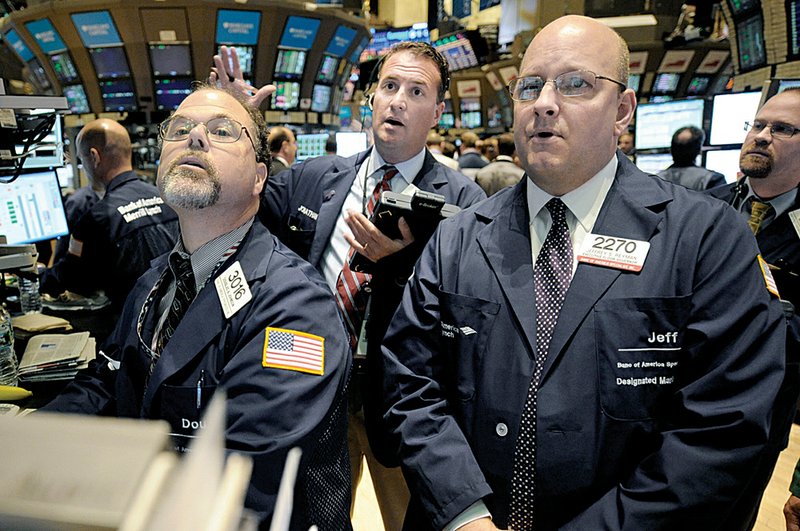WASHINGTON — The Federal Reserve signaled Tuesday that it’s worried about the weakness of the recovery and is ready to take further steps to help the economy if needed.
Fed officials said they are also concerned that sluggish economic growth could prevent prices from rising at a healthy rate.
But at the end of its meeting, the Fed announced no new steps to try to rejuvenate the economy and drive down unemployment. Instead, it hinted that it’s prepared to see if the economy can heal on its own.
Stock prices, which had been relatively flat before the Fed’s statement, fluctuated before returning to about the same level in late-afternoon trading.
The meeting is the last for the Fed’s chief policymaking group before the Nov. 2 midterm elections. It comes as voters are focused on the economy and the jobs crisis. Polls show they are likely to punish Democrats in Washington for the sluggish economy.
In its statement, the Fed used the same language it did in August to sketch a downbeat view of the economy. It concluded that economic activity has slowed in recent months. And it warned that the pace of growth is likely to be “modest in the near term” - almost identical to the assessment it made a month ago.
But the Fed delivered a stronger signal that it would take new steps to lift the economy. The Fed said it is“prepared to provide additional accommodation.” In its previous policy statements, the Fed didn’t go that far. Instead, it had said it would “employ its policy tools as necessary.”
The Fed made clear that given the economy’s weakness, it’s more concerned about prices falling than rising. It didn’t use the word deflation. But some economists have raised fears about the country sliding into a deflationary spiral. That’s a widespread drop in wages, prices of goods and services and the value of stocks and homes.
“They are more worried about the economy and deflation than I thought they would be,” said Sung Won Sohn, an economist at the Martin Smith School of Business at California State University.
For the sixth straight meeting, Thomas Hoenig, president of the Federal Reserve Bank of Kansas City, was the sole dissenter.
At Tuesday’s meeting, the Fed once again left a key short term rate near zero, where it has been since December 2008. It also repeated a pledge to hold rates at those ultra low levels for an “extended period.”
If the economy keeps losing momentum, the Fed will be likelier to provide relief at its next meeting on Nov. 2-3 or at its last regularly scheduled session of the year on Dec. 14.
Chairman Ben Bernanke last month indicated a preference to start a new program to buy large amounts of government debt. Such a move would be intended to lower already low rates on mortgages, corporate loans and other debt. The goal is to entice people and businesses to spend more, and thereby strengthen the economy and lower unemployment.
In economic circles, it’s known as “quantitative easing.” That’s when the Fed takes unconventional steps, as it did during the financial crisis, to inject money into the economy. The Fed does this to lower long-term interest rates and help banks lend more. As a result, the Fed’s balance sheet has ballooned to $2.3 trillion, nearly triple its level before the crisis.
Even if the Fed were to do that, economists don’t think it would be enough to increase economic growth much. Already low long-term rates haven’t managed to get Americans to spend much more. Both companies and individuals have been cautious as they rebuild their finances and pare debt.
Still, even with no guarantee that reducing long-term rates would stimulate the economy, the Fed can’t risk its credibility by standing idly if things worsen. Businesses and investors could lose faith in the Fed and the economy and be less inclined to spend. That would further weaken the economy.
At its last meeting in August, the Fed took a small step to aid the recovery: It decided to use proceeds from its huge mortgage portfolio and buy government debt. The small amount involved helped nudge down mortgage rates. But it would take a bigger round of buying to push rates down further.
Sohn predicted the Fed would start expanding its balance sheet before the end of the year.
“Even though they are not taking any action now, they have left the door open for additional action through buying Treasury bonds and mortgage backed securities,” he said.
Economic growth slowed in the second quarter, advancing at a pace of just 1.6 percent, compared with 3.7 percent growth in the first three months of the year. Growth in the July-September period is expected to be similarly weak. That raises the likelihood that the unemployment rate, already high at 9.6 percent, could climb even higher in the months ahead.
Information for this article was contributed by Liz Sidoti of The Associated Press.
Business, Pages 25 on 09/22/2010
